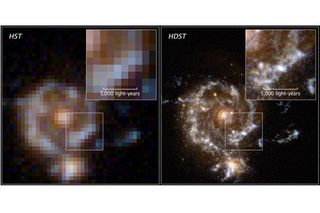
Will the 'Super Hubble' Space Telescope Find Alien Life? (Kavli Hangout)

Adam Hadhazy, writer and editor for The Kavli Foundation, contributed this article to Space.com's Expert Voices: Op-Ed & Insights.
Scientists have just unveiled a bold proposal for a giant, new, space-based telescope that would be far more powerful than today's observatories. Called the High Definition Space Telescope (HDST), the instrument is essentially a supersize Hubble Space Telescope, with 100 times its ability to detect faint starlight.
With an estimated cost of $8 billion to $9 billion, HDST would be a game changer, and if it advances beyond the concept phase, it would launch in the 2030s. With a mirror 25 times the size of Hubble's, HDST could delve deep into the universe's past to trace how gasses enriched with the elemental ingredients of life moved in and out of galaxies.
HDST also could examine dozens of Earth-like exoplanets that are too tiny for the Hubble telescope and its immediate successor, the James Webb Space Telescope, to see. HDST would scour their atmospheres for signs of alien life, perhaps finally answering whether humanity is alone in the cosmos.
The vision for the HDST was described in a July report spearheaded by the Association of Universities for Research in Astronomy (AURA), a consortium of global institutions that operate astronomical observatories.
To learn more about HDST's promise, join a live Kavli Foundation Google+ Hangout on Oct. 6 at 2 p.m. ET (1800 GMT). The Hangout participants will be AURA committee Co-Chairwoman Sara Seager, of the Kavli Institute for Astrophysics and Space Research at MIT, and Co-Chairwoman Julianne Dalcanton, of the University of Washington, as well as AURA committee member Marc Postman, of the Space Telescope Science Institute.
The scientists will answer questions about how HDST will trace cosmic evolution, from the primeval rise of chemical elements necessary for life to the potential for alien life right in Earth's cosmic backyard, plus how to build such a powerful instrument.
Get the Space.com Newsletter
Breaking space news, the latest updates on rocket launches, skywatching events and more!
Questions can be submitted ahead of and during this webcast by emailing info@kavlifoundation.org or by using the hashtag #KavliLive on Google+ or Twitter. To join the event, visit kavlifoundation.com.
About the participants:

Sara Seager — Seager is a professor of physics and planetary science at the Massachusetts Institute of Technology (MIT), an affiliated faculty member at the MIT Kavli Institute for Astrophysics and Space Research, and co-chairwoman of the HDST study. Her research specialty is exoplanet atmospheres and interiors.
Julianne Dalcanton — Dalcanton is a professor in the Department of Astronomy at the University of Washington and co-chairwoman of the HDST study. Her research focuses on the origin and evolution of galaxies.
Marc Postman — Postman is an astronomer at the Space Telescope Science Institute (STScI) and served on the committee for the HDST report. His research interests include galaxy-cluster and large-scale cosmic structure evolution and formation, along with large space telescope design and implementation.
Adam Hadhazy — The moderator, Hadhazy is a freelance science writer who principally covers astrophysics and astrobiology. He has a master's degree in science journalism from New York University.
Follow all of the Expert Voices issues and debates — and become part of the discussion — on Facebook, Twitter and Google+. The views expressed are those of the author and do not necessarily reflect the views of the publisher. This version of the article was originally published on Space.com.
Join our Space Forums to keep talking space on the latest missions, night sky and more! And if you have a news tip, correction or comment, let us know at: community@space.com.

Adam Hadhazy is a contributing writer for Live Science and Space.com. He often writes about physics, psychology, animal behavior and story topics in general that explore the blurring line between today's science fiction and tomorrow's science fact. Adam has a Master of Arts degree from the Arthur L. Carter Journalism Institute at New York University and a Bachelor of Arts degree from Boston College. When not squeezing in reruns of Star Trek, Adam likes hurling a Frisbee or dining on spicy food. You can check out more of his work at www.adamhadhazy.com.
